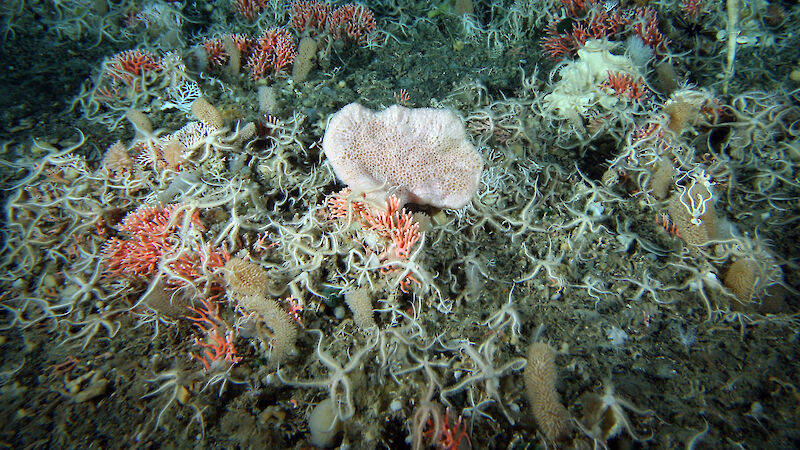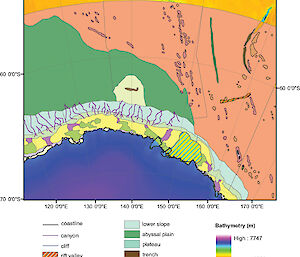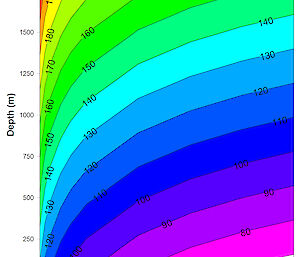New research is helping to predict the location of marine ecosystems vulnerable to bottom fishing and how different organisms within them respond to and recover from damaging impacts.
The Southern Ocean sea floor, off East Antarctica, is home to some of the world’s most ancient marine organisms, including slow growing sea fans and bamboo corals hundreds to thousands of years old. These and other habitat-forming denizens of the deep (such as sponges, sea whips, anemones, sea pens and bryozoans) have particular life history characteristics that make them vulnerable to bottom fishing (longlining and trawling). These characteristics include long life spans, slow growth rates and reproductive strategies that limit the number and dispersal of offspring.
The Commission for the Conservation of Antarctic Marine Living Resources (CCAMLR) has had conservation measures in place for benthic (sea floor) organisms for decades, to ensure sustainable use and conservation of Southern Ocean marine resources. In 2007 it added conservation measures for ‘vulnerable marine ecosystems’ (VMEs). Such ecosystems include fields of cold water corals and sponges, seamount communities (found on the slopes and tops of undersea mountains), and hydrothermal vent communities (where heated water, flowing through fissures in the earth’s crust, supports unique microorganisms). The measures help safeguard VMEs from bottom fishing impacts (longlining in CCAMLR waters) by requiring fishing vessels to cease operation if they encounter evidence of a VME (pulling up more than 10kg of material on one section of longline), and preventing future fishing in the area until appropriate management actions have been established.
In 2008 two 400 km2 regions of the Southern Ocean sea floor were declared VMEs (Australian Antarctic Magazine 15: 19, 2008), after large areas of high biodiversity were captured on a trawl-mounted camera. Another 28 areas are pending assessment by CCAMLR. However, there remains a vast lack of information about where such regions of biodiversity might occur in the Southern Ocean and how 'resistant' and 'resilient' the ecosystems are to disturbance. Answers to these questions are critical in helping CCAMLR manage fishing and conservation in its areas of responsibility in the Southern Ocean.To determine where VMEs are likely to occur in the Southern Ocean, scientists from Geoscience Australia have used publicly available bathymetry and geophysical data to develop large-scale maps (1:1–5 million) of the Antarctic continental margin and adjoining ocean basins (see map). These maps enable identification of features often associated with VMEs; for example, seamounts over a certain size and submarine canyons and mid-ocean ridge valleys, which harbour hydrothermal vents. A knowledge of the nature of these and other large geomorphic features (based on physical and biological sampling in some areas) can then be used to predict sea floor characteristics, such as whether it is hard or soft, and whether processes that affect sea floor characteristics are at work, such as iceberg scouring, sediment deposition or erosion, and ocean currents. This information can then be used to predict the location of VME habitat.
The next knowledge gap to be addressed is how different organisms within a VME respond to bottom fishing (resistance) and how long they take to recover (resilience).
'Resistance is the ability of an ecosystem to withstand interactions with bottom fishing gear, and depends on the physical and behavioural attributes of individual organisms and the spatial scale of fishing,' Australian Antarctic Division biologist, Dr Keith Martin-Smith says.
'Resilience is the ability of the ecosystem to recover structure and function following changes caused by bottom fishing activities.'
To measure resistance and resilience, Dr Martin-Smith and his colleagues collated a database of life-history characteristics for 28 groups of benthic, habitat-forming organisms, based on research from around the world. These characteristics included growth rate, life span, maximum size, and reproductive strategies. The database also included information on physical and chemical variables of the organisms' habitats, such as depth, temperature, oxygen concentration, salinity and nutrients.Analysis of the data found consistent relationships in all the groups between life-history characteristics and between life-history characteristics and physical or chemical variables. For example, long-lived organisms grew very slowly while shorter-lived organisms grew more quickly; organisms living in warmer water grew faster than those living in cold water; and organisms growing in deep water grew slower than those in shallower water.
Application of this information to questions of resistance and resilience in gorgonians (sea fans), some species of which have been aged at more than 700 years old, indicated that in ambient Southern Ocean conditions the organisms would likely take at least 130–200 years to recover from bottom fishing damage, depending on the depth at which they grew. (The deeper they grow, the more likely they will be to grow and recover slowly). Bryozoan colonies, which can live for an estimated 40–60 years, were predicted to take more than 50 years to recover.
Dr Martin-Smith says the research demonstrates that the relationships between life history characteristics, and life-history and environment, can be used as predictive tools to provide plausible values for resistance and resilience, where very few data are available.
'This means that the relative vulnerability of taxa can be predicted from currently available data, for use in risk management,' he says.
The work has been discussed at CCAMLR Working Groups and at a recent CCAMLR Workshop on Vulnerable Marine Ecosystems. The results are being used to inform further development of CCAMLR Conservation Measures.
WENDY PYPER
Corporate Communications, AAD



